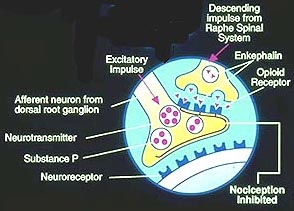Home, Search, Index, Links, Pathology, Molecules, Syndromes,
Muscle, NMJ, Nerve, Spinal, Ataxia, Antibody & Biopsy, Patient Info
|
Home, Search, Index, Links, Pathology, Molecules, Syndromes, Muscle, NMJ, Nerve, Spinal, Ataxia, Antibody & Biopsy, Patient Info |
|
Opioids Principles Specific medications Nonsteroidal Anti-inflammatory Other Nociceptors Painful Muscle Neuropathies Also see Itch Muscle Pain Principles Pain: General principles |
 From Roxane Institute |
| OPIOIDS 3 | ||||||
|---|---|---|---|---|---|---|
| PRINCIPLES 2 | ||||||
| ||||||
| SHORT-ACTING OPIOIDS A | LONG-ACTING OPIOIDSA | |||||
| Drug (MME) | Equivalent Doses | Drug | Equivalent Doses | |||
| Oral | Parenteral | Oral | Parenteral | |||
| Morphine (1) | 30 mg |
10 mg |
MS-Contin | 90 - 120 mg |
. | |
| Hydromorphone (4) | 7.5 mg |
1.5 mg |
Levorphanol | 4 mg |
2 mg |
|
| Codeine (0.15) | 200 mg |
. | Methadone (4-10) | 20 mg |
10 mg |
|
| Hydrocodone (1) | 30 mg |
. | Propoxyphene | . | . | |
| Oxycodone (1.5) | 30 mg |
. | Oramorph SR | 90 - 120 mg |
. | |
| Meperidine | 300 mg |
100 mg |
Oxymorphone (3) | . | 1 mg q 3-4 h | |
| Fentanyl (2.4) | IM or IV | Fentanyl | Transdermal: 25 μg patch @ 45 -135 mg Morphine p.o. over 24 h |
|||
|
Opioid-naive adults and children > 50 kg body weight MME = Morphene milligram equivalents | ||||||
| NON-STEROIDAL ANTI-INFLAMMATORY | ||||
|---|---|---|---|---|
| Salicylates | Phenylalkanoic Acid Derivatives | |||
| Drug | Typical dose | Drug | Typical dose | |
| Aspirin | 650 mg |
Ibuprofen | 400 mg |
|
| Diflunisal | 500 mg |
Naproxen | 500 mg |
|
| Salsalate | 1 g |
Fenoprofen | 300 mg |
|
| Trilisate | 750 mg |
Ketoprofen | 50 mg |
|
| Indoles | Flurbiprofen | 100 mg |
||
| Drug | Typical dose | Oxaprozin | . | |
| Indomethacin | 50 mg |
Napthylalkanone | ||
| Sulindac | 200 mg |
Drug | Typical dose | |
| Indole Acetic Acids | Nabumetone | 1 g qd | ||
| Drug | Typical dose | Fenamates | ||
| Tolmetin | 400 mg |
Drug | Typical dose | |
| Ketorolac | 30 mg IM/IV |
Meclofenamate | 50 mg |
|
| Pyranocarboxylic Acid | Mefenamic acid | 250 mg |
||
| Drug | Typical dose | Diclofenac | 50 mg |
|
| Etodolac | 400 mg |
Oxicam | ||
| Drug | Typical dose | |||
| Piroxicam | 20 mg qd | |||
| OTHER MEDICATIONS FOR PAIN | ||||
|---|---|---|---|---|
| Antidepressants | Anticonvulsants | |||
| Bedtime dose helps sleep & pain | Especially for lancinating pain | |||
| Drug | Typical dose | Drug | Typical dose | |
| Amitriptyline | 25 to 100 mg qhs | Carbamazepine | 200 mg |
|
| Desipramine | 75 mg qhs | Valproic acid | 250 mg |
|
| Nortriptyline | 75 mg qhs | Phenytoin | 100 mg |
|
| Fluoxetine | 20 mg qd | Clonazepam | 0.5 mg |
|
| Venlafaxine ER | 37.5 - 225 mg/d | Gabapentin | 600 mg |
|
| Paroxetine | Lamotrigine1 | 25 mg bid | ||
| Analgesics | Local Anesthetics | |||
| Drug | Typical dose | Drug | Typical dose | |
| Acetaminophen | 650 mg |
Mexiletine | 225 mg |
|
| Tramadol | 100 mg |
Flecainide | 150 mg |
|
| Steroids | Lidocaine | 1.5 mg/kg IV | ||
| Drug | Typical dose | Topical | ||
| Prednisone | 20-80 mg qd | Drug | Typical dose | |
| Dexamethasone | 4-16 mg qd | Capsaicin | Topical qid | |